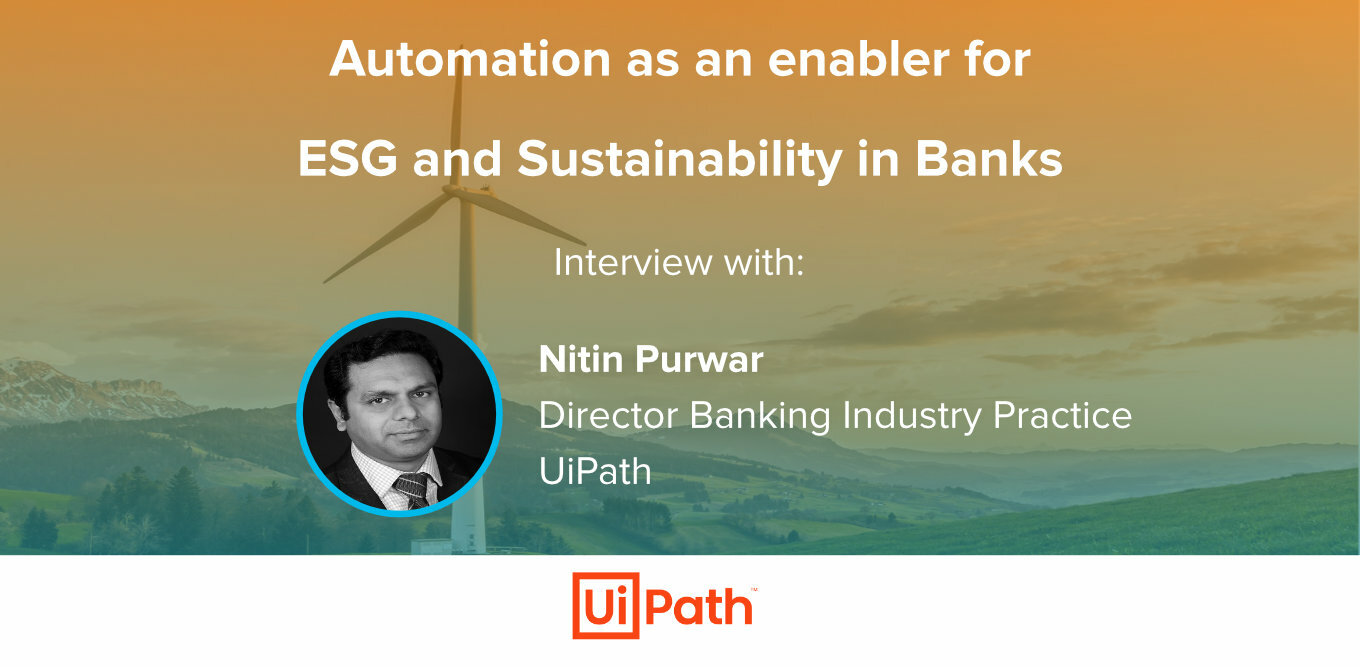
Insights & Opinions
Automation as an enabler for ESG and Sustainability in Banks: an interview with Nitin Purwar, UiPath
Thu, 26 Aug 2021


Rik Coeckelbergs: After many talks on automation, I am excited to be here with Nitin Purwar, Director of Banking Industry Practice at UiPath, for a chat on automation for good. Having organised many virtual roundtables with The Banking Scene myself on banking for good, I know that today, banks struggle to apply the vision and ambitions they have to improve and grow their contributions to a greener and better society.
Warm welcome, Nitin. According to you, and to the many conversations you had with your clients, how challenging are the new ESG and sustainability ambitions for financial institutions today?
Nitin Purwar: Thanks Rik, for having this discussion. Right now, there has obviously been an increased awareness around the whole ESG and sustainability piece, not just in the banking community.
Across organisations, across industries as a whole, there has been increased pressure from different stakeholders in the community. Shareholders, even your customers, the customers of the banks today, expect that the bank with whom they're banking is more focused on ESG and sustainability goals.
So I think bundling all of this together, obviously, banks and most of the other organisations are putting their efforts into ensuring that they are standing on the right side of the ESG and sustainability lens. All the organisations are making commitments across ESG and sustainability.
A lot of banks today have already committed to the net-zero carbon footprint, towards some time in the future. But then, especially when it comes to banking, it doesn't just stop there. A bank has to own its own carbon footprint responsibility. But like I said, it just doesn't stop there. Because as a bank, you have a larger impact on society and the way you are financing.
I'll give you an example. Very recently, I read that the top major four banks in Australia decided to stop financing the coal industry. Banks are starting to think, and these all these efforts do have an impact.
So now, banks are looking from the perspective to whom they finance, what kind of entities they finance. All this adds to the complexity and challenge for the banks. They are thinking of their own carbon footprint, from their own real estate from their own resources, but they also reflect how their business is impacting society around them. So I think that kind of adds to the challenge of the banks today.
Rik Coeckelbergs: Banks have built their own reality in the past, which is an entirely different reality than today, with, as we all know, a lot of legacy. How, according to you, can automation help banks to overcome these challenges and to anticipate much faster to ESG and sustainability?
Nitin Purwar: ESG is a big piece, and there are so many opportunities when it comes to how automation can be applied in a good way towards improving the overall ESG and sustainability efforts. I'll divide this into maybe three parts.
The first piece is the whole piece around how to maintain the overall commitment piece. Banks are making so many commitments today, and it's across different areas, from green financing commitments to commitments towards their own carbon footprint.
Rik Coeckelbergs: And much further also responsibility towards their customers.
Nitin Purwar: Absolutely. So, the first piece is how do you make sure that you are aligning to your commitments. How do you do that measurement, that reporting? ESG reporting has become a very big piece. Most of the global banks are producing extensive lending ESG reports. Preparing such reports requires a lot of data collection from different entities and different regions where these banks have a presence.
That becomes a big piece of opportunity from an automation perspective. Where can you apply automation to (1) measure how you are doing against these targets and then (2) prepare and collect all the data and add it into the proper forms, the right reporting. That's one big piece.
The second piece is kind of an enabler if I have to put it that way, the whole piece around improving the ‘total banking experience’. Today, even more than before, as customer experience has become a true differentiator, banks and many other organisations are trying to improve the interaction with customers while also not forgetting the undeniably linked employee experience. ‘Paperless’ and ‘digital’ are the buzzwords. That's another area where you will see automation as an enabler.
Obviously, by reducing your reliance on paper, you are reducing your overall carbon footprint.
Rik Coeckelbergs: So, on the one hand, it's reducing the carbon footprint of their own organisation, and on the other, it is reducing the carbon footprint of their customers, of the companies they invest in, or the credit they provide?
Nitin Purwar: That's the third piece, actually, which is around the whole financing bit. Like we were discussing earlier, banks have a ripple effect in the way they finance the communities around them. So that's another big piece. When you start thinking about green finance, it is a little different from your traditional lending, because you need to look at your customers in more detail.
Automation can be deployed to provide the data you need to evaluate your customer's carbon footprint. How does the customer's supply chain work? And what are the different regions? What are the different types of products your customer's business is aligning? All this will ensure that you can provide finances to the right kind of organisations, which align with your green finance loans.
These are the few areas where I believe automation can help banking organisations align with their sustainability goals.
Rik Coeckelbergs: One of the virtual roundtables I had was, was with Elisabeth Minjauw. She is the President of the European Mortgage Federation (read blog here). One of the takeaways I learned there, but also from other sessions with, for example, ABN AMRO, with Argenta and many other banks, is that banks will need to talk to multiple stakeholders in society to make a true impact for a greener future. Purely using their own data is no longer enough. That makes me wonder, in the context of automation, is RPA sufficient? Or do we need to look at more complex automation solutions?
Nitin Purwar: I think that's a good one. When I say automation, obviously, I don't just want to look at it from an RPA (robotic process automation) lens. You need a combination of technologies.
If I have to measure the carbon footprint of my employees, maybe RPA is sufficient because all I need to know is what the resources are they are consuming, which is not a very complex job. RPA can help you find out the carbon footprint across regions for your employees.
We talked about the whole paperless piece. That's where you need something on top of RPA. You need intelligent automation capabilities managing the entire document handling part. In most cases, banking is still a very traditional and document-heavy industry. Many documents that banks receive are very unstructured in nature. Just automating the digitization of the information is not sufficient Multiple other intelligent automation capabilities are required, like document understanding and handling unstructured data.
The whole green financing journey is another area that is gaining a lot of prominence. When we look at green financing, green mortgages and checking data points for these financing and market journeys, it's not just a plain simple rule-based thing. You need to skim through so much unstructured data points and you have to enable your software robots to reason over the data and use artificial intelligence (AI) to make decisions. Not to forget, different machine learning-based capabilities, to ensure your financing journeys are more seamless and simpler in nature.
Rik Coeckelbergs: Very insightful. And I really look forward to a more in-depth discussion on September 9, where we invite you again, of course, together with Chris Skinner, author and commentator of the Finanser, Kim Whitmore, Head of RPA, NatWest Wealth Businesses and Sultan Mahmood, Senior Partner Digital Operations, PwC
Nitin Purwar: So thank you very much. And looking forward to we're looking forward to that discussion on September 9.
You can still register for the September 9th session on the following page: The Banking Scene - Automation for Good: Automation as an enabler for ESG and Sustainability in Banks.



